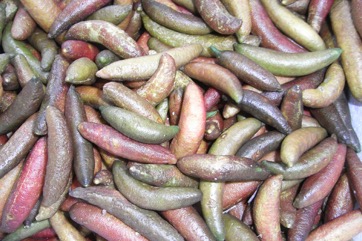Finger lime, Australian Finger Lime

It occurs naturally in Australia in Northen New South Wales and Southern Queensland. It grows in subtropical rainforest as an understorey tree. It grows on a range of soil types. It can tolerate light frosts. In Brisbane Botanical Gardens. It suits hardiness zones 10-11. Mt Cootha Botanical Gardens.
Synonyms
- Microcitrus australasica (F. Muell.) Swingle
Edible Portion
- Fruit
Where does Finger lime grow?
Found in: Australia
Notes: They contain up to 82 mg of Vitamin C per 100 g of raw material. There are 5 Microcitrus species.
Status: It is now grown commercially.
Growing Finger lime, Australian Finger Lime
Cultivation: Plants can be grown from seed. Seed germination is erratic. Seeds do not breed true to type and seed from one plant can give a range of fruit colours. They can be grown from cuttings on a heat bed but rooting is slow and can take 6 months. They can be budded onto citrus rootstocks. Because the buds are small this takes some skill to be successful.
Edible Uses: The fruit can be used fresh or for processing into jams, jellies, marmalade etc.
Production: Plants are slow growing. Seedling trees do not bear true to type. The entire range of fruit colours can develop from seed from a single fruit. Seedling trees can take 5 to 17 years to produce fruit. Flowering and fruiting can occur several times throughout the year. Up to 186 g of fruit per tree have been harvested from wild trees. Fruit from natural populations vary considerably in shape, size, colour, seediness and acidity. A fruit weighs about 7-42 g at maturity.
Nutrition Info
per 100g edible portion| Edible Part | Energy (kcal) | Protein (g) | Iron (mg) | Vitamin A (ug) | Vitamin c (mg) | Zinc (mg) | % Water |
|---|---|---|---|---|---|---|---|
| Fruit | 98 | 2.5 | 0.8 | - | - | 0.3 | 65.5 |
| Fruit | - | 1.7 | 0.6 | - | 82 | 0.2 | 76.7 |
Finger lime, Australian Finger Lime Photos

References
Alice, L. & O'Quinn, T., Australian Bush Superfoods. Explore Australia p 54 (As Microcitrus australasica)
Birmingham, E. , 1998, Australian native citrus: wild limes from the rainforest to the desert.. in The Australian New crops Newsletter No 10, p 21.1
Bodkin, F., 1991, Encyclopedia Botanica. Cornstalk publishing, p 699
Bonney, N., 1997, Economic Native Trees and Shrubs for South Australia. Greening Australia (SA) inc. Campbelltown SA 5074 p 168
Cherikoff V. & Isaacs, J., The Bush Food Handbook. How to gather, grow, process and cook Australian Wild Foods. Ti Tree Press, Australia p 146
Cribb, A.B. & J.W., 1976, Wild Food in Australia, Fontana. p 41
Elliot, W.R., & Jones, D.L., 1993, Encyclopedia of Australian Plants suitable for cultivation. Vol 6. Lothian. p 395 (Photo)
Etherington, K., & Imwold, D., (Eds), 2001, Botanica's Trees & Shrubs. The illustrated A-Z of over 8500 trees and shrubs. Random House, Australia. p 214 (As Citrus australasica)
Facciola, S., 1998, Cornucopia 2: a Source Book of Edible Plants. Kampong Publications, p 221
Fragm. 1:26. 1858
Hamilton, K., 2007, Ex Situ Conservation of Australian Citrus species:Investigations on Seed Biology, Cryopreservation and in vitro culture. Ph.D Thesis Griffith University, Queensland Australia.
Hibbert, M., 2002, The Aussie Plant Finder 2002, Florilegium. p 197
Jones D, L, 1986, Ornamental Rainforest Plants in Australia, Reed Books, p 114, 340 (As Microcitrus)
Kiple, K.F. & Ornelas, K.C., (eds), 2000, The Cambridge World History of Food. CUP p 1821
Lazarides, M. & Hince, B., 1993, Handbook of Economic Plants of Australia, CSIRO. p 163
Lord, E.E., & Willis, J.H., 1999, Shrubs and Trees for Australian gardens. Lothian. p 18
Low, T., 1991, Wild Food Plants of Australia. Australian Nature FieldGuide, Angus & Robertson. p 69
Low, T., 1992, Bush Tucker. Australia’s Wild Food Harvest. Angus & Robertson. p 61
Lyle, S., 2006, Discovering fruit and nuts. Land Links. p 126 (As Citrus australasica)
Nicholson, N & H., 1996, Australian Rainforest Plants 2, Terania Rainforest Publishing. NSW. p 42
Smith, K & I., 1999, Grow your own bushfoods. New Holland. Australia. p 52
USDA, ARS, National Genetic Resources Program. Germplasm Resources Information Network - (GRIN). [Online Database] National Germplasm Resources Laboratory, Beltsville, Maryland. Available: www.ars-grin.gov/cgi-bin/npgs/html/econ.pl (10 April 2000)
Williams, J.B., Harden, G.J., and McDonald, W.J.F., 1984, Trees and shrubs in rainforests of New South Wales and Southern Queensland. Univ. of New England, Armidale. p 60
World Checklist of Useful Plant Species 2020. Royal Botanic Gardens, Kew